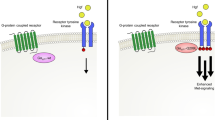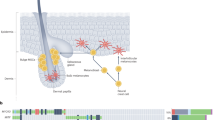Abstract
Many studies have highlighted the critical role of c-Kit in normal melanocyte development but its role in melanoma development remains unclear. Although c-Kit expression is often lost during melanoma progression, a subset of melanoma has been found to overexpress c-Kit and mutations activating c-Kit have recently been identified in some acral and mucosal melanoma. To address the role of these c-Kit mutants in the transformation of melanocytes, we characterized the physiological responses of melanocytes expressing the most frequent c-Kit mutants found in melanoma (K642E and L576P) and a novel mutant we identified in an acral melanoma. We analysed signaling pathways activated downstream of c-Kit and showed that all three mutants led to a strong activation of the phosphatidyl-inositol-3 kinase (PI3K) pathway but only weak activation of the Ras/Raf/Mek/Erk pathway, which was not sufficient to promote uncontrolled melanocyte proliferation and transformation. However, in hypoxic conditions or coexpressed with a constitutively active form of hypoxia-inducible factor 1α (HIF-1α), c-Kit mutants activate the Ras/Raf/Mek/Erk pathway, stimulate proliferation and transform melanocytes. Proliferation of melanocytes transformed by these mutants was specifically inhibited by imatinib. These results show for the first time that melanocytes require a specific epigenetic environment to be transformed by c-Kit mutants and highlight a distinct molecular mechanism of melanocyte transformation.
This is a preview of subscription content, access via your institution
Access options
Subscribe to this journal
Receive 50 print issues and online access
$259.00 per year
only $5.18 per issue
Buy this article
- Purchase on Springer Link
- Instant access to full article PDF
Prices may be subject to local taxes which are calculated during checkout








Similar content being viewed by others
References
Alexeev V, Yoon K . (2006). Distinctive role of the cKit receptor tyrosine kinase signaling in mammalian melanocytes. J Invest Dermatol 126: 1102–1110.
Beadling C, Jacobson-Dunlop E, Hodi FS, Le C, Warrick A, Patterson J et al. (2008). KIT gene mutations and copy number in melanoma subtypes. Clin Cancer Res 14: 6821–6828.
Bedogni B, Welford SM, Cassarino DS, Nickoloff BJ, Giaccia AJ, Powell MB . (2005). The hypoxic microenvironment of the skin contributes to Akt-mediated melanocyte transformation. Cancer Cell 8: 443–454.
Bennett DC, Cooper PJ, Hart IR . (1987). A line of non-tumorigenic mouse melanocytes, syngeneic with the B16 melanoma and requiring a tumour promoter for growth. Int J Cancer 39: 414–418.
Busca R, Berra E, Gaggioli C, Khaled M, Bille K, Marchetti B et al. (2005). Hypoxia-inducible factor 1{alpha} is a new target of microphthalmia-associated transcription factor (MITF) in melanom. J Cell Biol 170: 49–59.
Curtin JA, Busam K, Pinkel D, Bastian BC . (2006). Somatic activation of KIT in distinct subtypes of melanoma. J Clin Oncol 24: 4340–4346.
da Rocha Dias S, Friedlos F, Light Y, Springer C, Workman P, Marais R . (2005). Activated B-RAF is an Hsp90 client protein that is targeted by the anticancer drug 17-allylamino-17-demethoxygeldanamycin. Cancer Res 65: 10686–10691.
Dumaz N, Hayward R, Martin J, Ogilvie L, Hedley D, Curtin JA et al. (2006). In melanoma, RAS mutations are accompanied by switching signaling from BRAF to CRAF and disrupted cyclic AMP signaling. Cancer Res 66: 9483–9491.
Garraway LA, Widlund HR, Rubin MA, Getz G, Berger AJ, Ramaswamy S et al. (2005). Integrative genomic analyses identify MITF as a lineage survival oncogene amplified in malignant melanoma. Nature 436: 117–122.
Geissler EN, Ryan MA, Housman DE . (1988). The dominant-white spotting (W) locus of the mouse encodes the c-kit proto-oncogene. Cell 55: 185–192.
Giebel LB, Spritz RA . (1991). Mutation of the KIT (mast/stem cell growth factor receptor) protooncogene in human piebaldism. Proc Natl Acad Sci USA 88: 8696–8699.
Gray-Schopfer V, Wellbrock C, Marais R . (2007). Melanoma biology and new targeted therapy. Nature 445: 851–857.
Hodi FS, Friedlander P, Corless CL, Heinrich MC, Mac Rae S, Kruse A et al. (2008). Major response to imatinib mesylate in KIT-mutated melanoma. J Clin Oncol 26: 2046–2051.
Huang LE, Willmore WG, Gu J, Goldberg MA, Bunn HF . (1999). Inhibition of hypoxia-inducible factor 1 activation by carbon monoxide and nitric oxide. Implications for oxygen sensing and signaling. J Biol Chem 274: 9038–9044.
Jiang X, Zhou J, Yuen NK, Corless CL, Heinrich MC, Fletcher JA et al. (2008). Imatinib targeting of KIT-mutant oncoprotein in melanoma. Clin Cancer Res 14: 7726–7732.
Lassam N, Bickford S . (1992). Loss of c-kit expression in cultured melanoma cells. Oncogene 7: 51–56.
Lennartsson J, Jelacic T, Linnekin D, Shivakrupa R . (2005). Normal and oncogenic forms of the receptor tyrosine kinase kit. Stem Cells 23: 16–43.
Lutzky J, Bauer J, Bastian BC . (2008). Dose-dependent, complete response to imatinib of a metastatic mucosal melanoma with a K642E KIT mutation. Pigment Cell Melanoma Res 21: 492–493.
Muchemwa FC, Ma D, Inoue Y, Curtin JA, Bastian BC, Ihn H et al. (2008). Constitutive activation of the phosphatidyl inositol 3 kinase signalling pathway in acral lentiginous melanoma. Br J Dermatol 158: 411–413.
Natali PG, Nicotra MR, Sures I, Santoro E, Bigotti A, Ullrich A . (1992). Expression of c-kit receptor in normal and transformed human nonlymphoid tissues. Cancer Res 52: 6139–6143.
Pratilas CA, Taylor BS, Ye Q, Viale A, Sander C, Solit DB et al. (2009). (V600E)BRAF is associated with disabled feedback inhibition of RAF-MEK signaling and elevated transcriptional output of the pathway. Proc Natl Acad Sci USA 106: 4519–4524.
Roskoski Jr R . (2005). Structure and regulation of Kit protein-tyrosine kinase—the stem cell factor receptor. Biochem Biophys Res Commun 338: 1307–1315.
Serve H, Yee NS, Stella G, Sepp-Lorenzino L, Tan JC, Besmer P . (1995). Differential roles of PI3-kinase and Kit tyrosine 821 in Kit receptor-mediated proliferation, survival and cell adhesion in mast cells. EMBO J 14: 473–483.
Solit DB, Garraway LA, Pratilas CA, Sawai A, Getz G, Basso A et al. (2006). BRAF mutation predicts sensitivity to MEK inhibition. Nature 439: 358–362.
Voytyuk O, Lennartsson J, Mogi A, Caruana G, Courtneidge S, Ashman LK et al. (2003). Src family kinases are involved in the differential signaling from two splice forms of c-Kit. J Biol Chem 278: 9159–9166.
Acknowledgements
We thank Professor Richard Marais for 501mel cells and pMCEF vector, Dr Lars Rönnstrand for a wild-type c-Kit expression vector and Dr Frank Bunn for the vector expressing HIF-1α (401Δ603). This work was funded by INSERM, Université Paris XII, Société Française de Dermatologie, Ligue Contre le Cancer (Comité du Val de Marne) and Institut National du Cancer.
Author information
Authors and Affiliations
Corresponding author
Supplementary information
Rights and permissions
About this article
Cite this article
Monsel, G., Ortonne, N., Bagot, M. et al. c-Kit mutants require hypoxia-inducible factor 1α to transform melanocytes. Oncogene 29, 227–236 (2010). https://doi.org/10.1038/onc.2009.320
Received:
Revised:
Accepted:
Published:
Issue Date:
DOI: https://doi.org/10.1038/onc.2009.320
Keywords
This article is cited by
-
Hypoxia-dependent drivers of melanoma progression
Journal of Experimental & Clinical Cancer Research (2021)
-
Vulvar Melanoma: Molecular Characteristics, Diagnosis, Surgical Management, and Medical Treatment
American Journal of Clinical Dermatology (2021)
-
Hypoxia and MITF regulate KIT oncogenic properties in melanocytes
Oncogene (2016)
-
Conditional Deletion of Kit in Melanocytes: White Spotting Phenotype Is Cell Autonomous
Journal of Investigative Dermatology (2015)
-
Constitutive activation of the ERK pathway in melanoma and skin melanocytes in Grey horses
BMC Cancer (2014)



